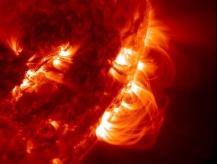Laboratory Astrophysics
Contact persons: Andy Higginbotham, Chris Ridgers and Nigel Woolsey

Laboratory astrophysics uses the fact that laws that govern physical processes on Earth apply throughout the Universe. This enables us to develop laboratory experiments to reproduce and study similar physics that occurs in remote, and in some cases extreme, reaches of the Universe. At the York Plasma Institute we study a vast range of astrophysical plasma phenomena in the laboratory. This spans the material properties of warm and hot dense matter, processes that magnetise our Galaxy, shocks and photon fields that accelerate cosmic rays. We get to study some of the physics that occurs in exotic objects such as exoplanets, brown dwarf (or failed) stars, supernovae and their remnants, protostellar jets as well as pulsars and gamma ray bursts.
Our research is highly collaborative and multinational. We apply theory and advanced computational techniques as well as develop measurement concepts to maximise the science from our use of extremely powerful and intense laser systems, both small and very large, from across the world. If you are inspired and interested, with an interest in some of the fundamental questions about how dense matter physics, plasma physics, QED and lasers apply to our universe please get in touch and we’ll arrange a visit.
Publications
C.E. Wehrenberg et al., In situ X-ray diffraction measurement of shock-wave-driven twinning and lattice dynamics, Nature 550, 496 (2017)
C.K. Li et al., Scaled laboratory experiments explain the kink behaviour of the Crab Nebula jet, Nature Comms 7, 13081 (2016)
J. Cross et al., Laboratory analogue of a supersonic accretion column in a binary star system, Nature Comms 7, 11899 (2016)
N. Booth, et al., Laboratory measurements of resistivity in warm dense plasmas relevant to the microphysics of brown dwarfs, Nature Comms 6, 8742 (2015)
J. Meinecke et al., Turbulent amplification of magnetic fields in laboratory laser-produced shock waves, Nature Physics 10, 520–524 (2014)
T. G.; Blackburn, et al. Quantum Radiation Reaction in Laser-Electron-Beam Collisions, Phys Rev Lett, 112, 015001 (2014)
